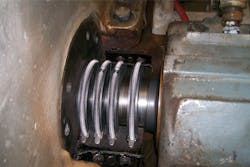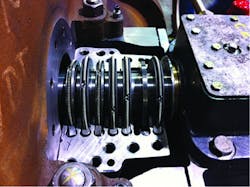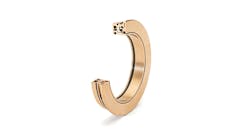Gland sealing in general purpose steam turbines
When it comes to dynamic sealing, the "best solution" is not always the "right solution." Economics play heavily into seal selection. A user must weigh the benefits of reduced leakage — improved efficiency, reduced emissions and/or increased reliability — against the cost to purchase and install the seal. Brush seals, a proven technology often used in aerospace developments, provide one cost-effective way to upgrade sealing in turbomachinery.
Dynamic seals generally fall into one of two product families: rigid geometry or compliant geometry. When a rigid geometry seal contacts the rotor — an event known as a "rub" — it typically results in the permanent removal of effective sealing material, increasing leakage. In contrast, compliant geometry seals track rotor movement with minimal loss of effective sealing material when a rub is experienced. The machine returns to steady-state performance with minimal increase in leakage.
Brush seals fall into the category of compliant sealing. Densely packed bristles bend with rotor contact, giving brush seals an innate ability to follow rotor movement with minimal wear. Brush seals can be particularly effective in reducing leakage gaps that occur from large thermal differences between rotating and stationary components and/or from significant radial movement of the rotor.
Large gas and steam turbine applications commonly employ brush seals to reduce the leakage gap experienced with labyrinth seals, increasing operational efficiencies. In general-purpose steam turbines, brush seals enhance carbon rings’ performance and longevity.
Steam generation for the support of operations is commonplace in many refineries, petrochemical plants and food processing facilities. Where different processes require different steam conditions, steam pressure may need to be knocked down from one process to another. The simplest solution is to use a pressure-reducing valve, but a more efficient alternative is to do work with the available energy. A general purpose steam turbine does just that. The turbine knocks down the steam pressure by converting it into rotational energy to drive a small pump, a compressor or other equipment. General purpose steam turbines are typically classified with output ratings below 3,500 horsepower (2.6 megawatts).
Conventional carbon rings
Conventional gland sealing in general purpose steam turbines is accomplished with carbon rings. A carbon ring has three segments held together with a garter spring. Typically, the steam end and exhaust end gland boxes each carry four to five carbon rings, though some may have more. Unlike labyrinth seals, carbon rings are not rigidly mounted into a turbine’s casing. The segments are installed on the turbine’s rotor in a gland pocket (see Image 1).
Carbon rings have two sealing surfaces: a face seal to the downstream wall of the gland pocket and a shaft seal to thex rotor surface. The face seal prevents steam from traveling around the carbon ring while the shaft seal, the ring’s inner bore, controls steam leakage along the turbine’s rotor. With operation and time, wear to the carbon bore opens its shaft clearance, causing steam leakage to increase. This increase in steam leakage negatively affects operational and maintenance costs.
Leaking steam can flow into the bearing sump, contaminating the lubricating oil or thermally increasing the bearing oil temperature. Oil contamination and higher oil temperatures will degrade bearing performance and increase the potential for bearing failure. In addition, the natural composition of carbon may break down in a steam environment, which can result in excessive leakage and subsequent erosion of the gland box.
Image 2. Floating brush seal
Applying the brush seal
The incorporation of brush seal technology into general purpose steam turbine carbon rings mitigates carbon wear at the rotor interface and significantly reduces steam leakage. This hybrid solution is the floating brush seal (FBS). The FBS, shown in Image 2, uses brush seal technology as the primary shaft seal while a carbon ring provides face sealing in the gland box. This combination of the two technologies provides an effective and self-centering assembly that is a drop-in replacement for conventional carbon rings.
With the brush seal technology on the upstream side of the gland box, the bristle pack reduces the pressure on downstream seals while acting as a natural excluder to filter out steam contaminants. The added benefit with a brush seal is prolonged seal life and a lower, more stable leakage rate. "The floating brush seal not only reduces steam leakage and bearing oil contamination, it also reduces the erosion we typically see inside the gland box when end users have steam purity issues," explained Michael Godzwon, manager, Technical Support at Dresser-Rand.
The first FBSs for general purpose steam turbines were introduced to the marketplace in the early 2000s to address complaints about carbon rings from equipment operators. A brush ring was contained in a stainless steel carrier, much like a brush seal for a jet engine. However, the all-metal construction of these first floating brush seals made them too heavy, and the seals did not float. The bristle pack wore out too quickly under the seal’s own weight. To lighten the assembly, a carbon ring was reintroduced.
The second-generation FBSs — the hybrid solution described above — made their way into the market around 2007. The FBS described in this article is a split design held together with a garter spring. The likeness to conventional carbon rings makes FBSs easy to install without having to remove the rotor and eliminates the need for costly casing modifications that may be required by other seal technologies.
Image 3. Gland box with two FBS upgrades
Typically, two FBSs are installed in each gland box (see Image 3). Downstream seals are replaced with new carbon rings.
Less maintenance & lower leakage
Early adopters of this FBS tested its capabilities on their most troublesome turbines. Wet steam conditions and cyclic operations were taking their toll on the carbon ring performance. The result was heavy maintenance and costly steam losses. One customer was changing out carbon rings every three to four months. Another had a visible condensate cloud after just four weeks.
In both cases, this FBS was able to alleviate their problems. Maintenance intervals were extended to three to four years. Steam leakage rates declined by nearly 70 percent, and bearing oil temperatures were reduced by as much as 27°C (80°F). Since these early successes, hundreds of the FBSs have been installed. This technology is available for a range of general purpose steam turbines.
Peter Zanini is the business development and product line director for brush seals at Waukesha Bearings Corporation, serving customers through the Waukesha Bearings, Bearings Plus and Inpro/Seal business units. Previously, Zanini worked on advanced brush seal designs as director of industrial sales at Rexnord Aerospace and developed industrial applications for aerospace sealing products at PerkinElmer Fluid Sciences (formerly EG&G Sealol and now Eaton Aerospace). Before entering the seal industry, Zanini worked for General Electric, Siemens Energy and Pratt & Whitney (Turbo Power and Marine Systems) in the development of industrial gas turbines. He holds a Bachelor of Science degree in mechanical engineering from Worcester Polytechnic Institute. He may be reached at [email protected] or 860-673-4096.
Jong Kim, Ph.D., is a senior principal engineer at Waukesha Bearings Corporation and a senior consulting engineer at Bearings Plus. Kim has overall responsibilities for rotordynamic analysis, bearing upgrades and bearing/seal technologies including Flexure Pivot bearings, ISFD technology and brush seals. Kim joined Waukesha Bearings in 2011. From 2001 to 2011, he worked for KMC and Bearings Plus. Kim received his Bachelor of Science degree in mechanical engineering from Busan National University and his Master of Science degree in mechanical engineering and his doctorate in mechanical engineering from Korea Advanced Institute of Science and Technology. He may be reached at [email protected] or 262-506-3055.
The Sentinel Floating Brush Seal described in this article is produced and supported by Inpro/Seal, a Waukesha Bearings business. For more information, visit inpro-seal.com.




